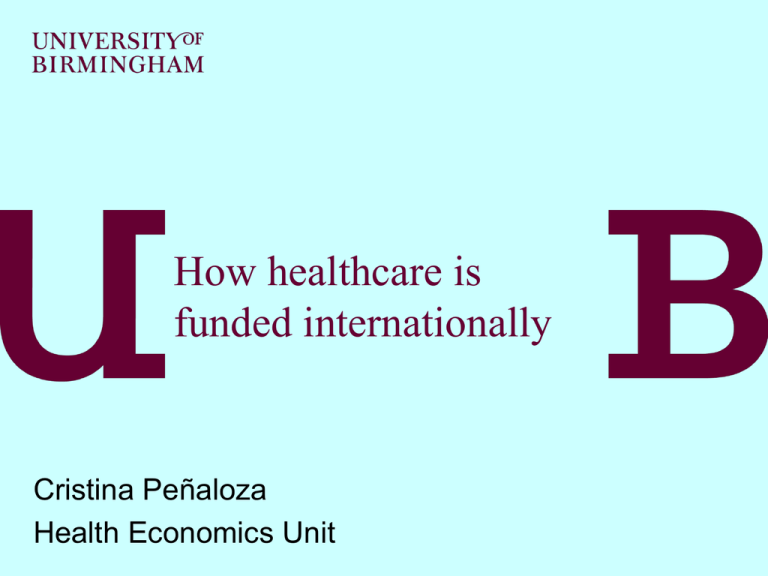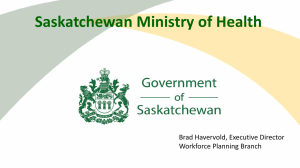How healthcare is funded internationally
advertisement

How healthcare is funded internationally Cristina Peñaloza Health Economics Unit Overview Define Healthcare & Healthcare systems – Demographic changes and disease burden – Epidemiological transition Alternative financing mechanisms of healthcare systems – Public / private mix / community-based – Raising finances (revenue collection, risk pooling/ problems prevalent) – Methods of providers purchasing and paying healthcare Learning Objectives By the end of the session, students should be able to: Understand health systems in terms of approaches to revenue collection, risk pooling, purchasing and paying healthcare providers Discuss the alternative sources of funding for healthcare systems Why look at financing mechanisms? A way of distinguishing between healthcare systems Help understand roles private & public sector play in healthcare sector Help understand govt. policy in healthcare sector (up to 16% of GDP spent on Healthcare) Defining healthcare “All goods and services designed to promote health, including “preventive, curative and palliative interventions, whether directed to individuals or to populations” (WHO) Healthcare is provided through healthcare systems Defining healthcare systems all activities whose primary purpose is to promote, restore or maintain health (WHO) Health financing, demographic changes and epidemiological transition Health financing, demographic changes and disease burdens 9 billion 7.5 billion 6 billion Source: United Nations 2005 Health financing and epidemiological transition Source: WHO, 2004 Health financing and epidemiological transition Source: WHO, 2004 Implications of demographic changes for health financing (projections 2005-25) Source: Gottret & Schieber. The World Bank 2006 Health financing Health financing functions Source: Schieber and Maeda 1997, The World Bank Risk pooling Collection and management of financial resources in a way that unpredictable individual financial risks become predictable, and are distributed among all the members of the pool Source: The World Bank Risk pooling mechanisms Four types of health insurance are widely used to pool risks, raise revenues, purchase services and pay to providers: National health service Social security Voluntary private health insurance Community-based health insurance No pure mechanism, usually a mix of two or more methods Purchasing Large variety of arrangements: National health services and Social Security organizations provide services in publicly owned facilities (staff members are public employees) Individuals or organizations purchase services through direct payments or contracting arrangements from public and private providers (or combination of the previous two) Resource allocation and purchasing decisions have important implications for cost, access, quality, and consumer satisfaction Market structures for purchasing and remuneration of providers Source: The World Bank, adapted from Kutzin 2001. Health systems National (state-funded) health care system Characteristics: funding comes from general revenues, universal coverage, a public health delivery system Strengths: comprehensive coverage of the population, and large scope for raising resources Weaknesses: unstable funding; disproportionate benefits for the rich; potential inefficiency in health care delivery; and sensitivity to political pressures Social health insurance (Bismarckian system) Characteristics: funding from employee and employer contributions; management through sickness funds; benefit package for all members (fully or partially cover) Strengths: more resources in the system; less dependence on budget negotiations; high redistributive dimension (cross subsidies) Weaknesses: possible exclusion of the poor; negative economic impact on payroll contributions; complex and expensive to manage; escalating costs; poor coverage of chronic diseases and preventive care Voluntary (private) health insurance Characteristics: affiliation is voluntary; it plays as the primary or additional source of healthcare funding; it may be the main source of health coverage, or duplicate health benefits or cover services not included by the public service Strengths: affords financial protection; enhances access to health services; increases service capacity and promotes innovation; helps finance health care services not covered publicly (OECD, 2004) Voluntary (private) health insurance Weaknesses: financial barriers to access; differential access to health care; not served to quality improvement; increased total health expenditure; high administrative costs; removed very little cost pressure from public health financing Community-based health insurance Characteristics: community membership; high community involvement in managing the system; beneficiaries are excluded from other kinds of health coverage; members share a set of social values (voluntary affiliation, participation and solidarity) Strengths: better access to healthcare for lowincome people; complete or fill the gaps of other health financing schemes Weaknesses: limited protection for members; sustainability is questionable; limited benefits to the poorer part of the population Aspects of the healthcare market to be controlled Consumer moral hazard – A zero (or reduced) price at the point of use encourages a higher rate of use than would otherwise be considered efficient Adverse selection – The process whereby the ‘best risk’ individuals are selected out of a general insurance pool Provider moral hazard (SID) – Incentives on suppliers (e.g. physicians) to provide care in excess of (or short of) that which would be arrived at by trading with fully informed consumers Some topics of interest Financing mechanisms in high-income countries Source: OECD 2004 Private Health Insurance in OECD countries What we have done in this lecture… Defined Health care & Healthcare systems Depicted the different health systems with examples from around the world Considered ways of revenue collection, risk pooling, purchasing and paying providers Discussed Methods of raising finances for healthcare systems (no pure mechanism) Conclusions All health systems characterised by public / private mix. Different methods of risk pooling, purchasing services, paying providers – not devoid of problems Broadly 3 alternative financing approaches (No pure mechanism). References Donaldson C, Gerard K. 1989. Countering Moral Hazard in Public and Private Health-Care Systems – A review of Recent Evidence J Soc Policy. 18(2):235-51 Donaldson C, Gerard K. 2004. Economics of Health Care Financing (2nd edition). Palgrave, (Chapters 4 and 5) Gottret P, Shieber G. 2006. Health Financing Revisited, A Practitioner’s Guide. The World Bank Keen J, Light D, Mays A. 2001. Public-Private Relations in Health Care. King’s Fund References Maynard A (ed). 2005. The Public-Private Mix for Health. The Nuffield Trust Morris S, Devlin N, Parkin D. 2007. Economic analysis in health care. Chichester: John Wiley & Sons OECD 2004, Health Data, 3rd Edition. Paris The World Bank. 2006. Health Financing Revisited, A Practitioner’s Guide. Schieber, G. Maeda, A. 1997. “A Curmudgeon’s Guide to Financing Health in Developing Countries”. In Schieber, ed. Innovations in Health Care Financing. Discussion Paper 365, The World Bank, Washington D.C.




